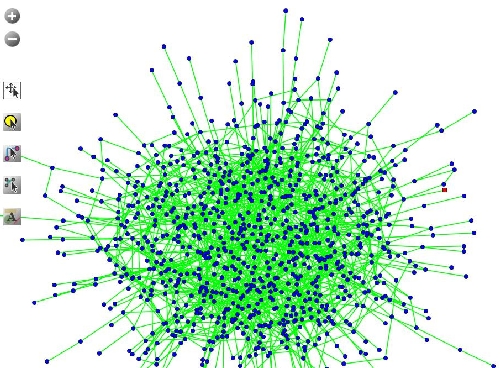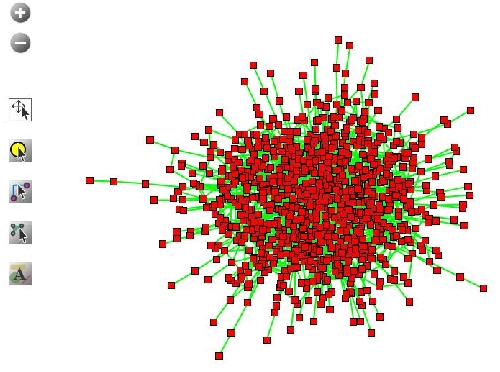I spent part of a long rainy afternoon two weekends ago slaying a Giant with a small pebble. No, it wasn’t a new video game. The Giant is the large connected component that can crop up in random graphs. Random graphs, as you may recall, are used as a modeling tool to analyze social networks—Facebook, Twitter, the Internet itself—and I wrote a post last month about one social scientist’s contrarian research in this area. In that post, there was a somewhat irregular and perplexing (for me, anyway) diagram that explains why, under certain circumstances, the “Tipping Point” concept championed by Malcolm Gladwell may not tell the whole story.
The researcher is Duncan Watts, a professor of Sociology at Columbia University and currently a visiting scholar at Yahoo. Back in 2002, Watts wrote a paper entitled A simple model of global cascades on random network in which he offered an analytic framework and empirical results showing that low-connectivity, non-mavens can tip or cascade a network. If you’ve gotten this far (admit it, you want to see a random graph), then you can read about my own attempt to recreate some of Watts’ results using a very good graphing analytics package that even a 3-year old can master.
The theory behind The Tipping Point and by extension viral marketing is that highly connected and persuasive mavens seize on an idea and are able to “infect” others, helping to spread their passions and product preferences throughout the larger social network.
I’ve simplified Gladwell’s argument. He does also mention another important factor in idea dispersion, called stickiness. A sticky idea (newly launched brand, improved product feature, political platform) is one that even non-mavens find attractive and are likely to spread.
Watts decided to more formally investigate idea dispersal among early adopters (see this on the terminology of innovation diffusion ). He quantified stickiness as a threshold level, a numeric value that represents the percentage of neighbors that need to accept or vote yes in order for ideas to stick to the next adopter. For example, if my threshold is .25 and one or more of my four immediate neighbors is raving about buying the Avatar DVD, then I will too.
The emphasis is on s i m p l e: Watts employs a single threshold value for the members in his theoretical social network, and adopters vote either yes or no (“binary decision”) on whether to accept the idea.

Giant Component (z=3,?-.24). Cascade blocked by “maven” node.
The structure of the social network is provided by a random graph, specifically of the Erdös-Rényi flavor. While these graphs don’t truly represent real-world networks (the distribution of the number of neighbors is not skewed enough ), they’re more tractable and a good starting point to test out theories.
An amazing characteristic of the E-R random graph is that significant features emerge at a critical value or phase transition point. One feature is the magical formation of connected components or “neighborhoods”—collections of nodes in which there’s a path connecting a member to any other member node. It’s almost geographic when visualized.
It turns out that one neighborhood dominates, and it only appears when the average-number-of-neighbors input parameter for a random graph generator falls above 1. That is, everyone knows, on average, one other person.
Called the Giant Component (and there is only one in a random graph), it is the Giant I referred to in the beginning of this post. Common sense would suggest that it is much easier to diffuse ideas globally within a large connected component. In one of the much, much smaller non-giant neighborhoods, really islands, you can only infect a small percentage of the network. Whereas the Giant represents a significant percentage of the total social network.
[Editor’s note: I think I’m following this, continue on…. ]
Watts discovered that to tip or cascade an idea across every node in the Giant, he really didn’t need to leverage highly connected nodes. In fact, maven nodes act as dampeners. Since these social nodes have so many neighbors, they require more of them to vote yes than a less connected node in order to exceed the threshold percentage and therefore tip. [Editor: OK, so if I have 10 neighbors and one adopts, that’s .1, but if my threshold is .24 I won’t tip.]
Yes, I know it’s beginning to sound like Watts has tipped his model against Gladwell’s view. If you set a low enough threshold, and low average neighbor count, it should be easy enough to get the Giant Component to become completely turned on.

Random graph (z=3,?-.24). Giant Component cascade succeeded.
This is what I found in my own personal exploration of the Giant (and which Watts reported on his paper.) You just don’t need the mavens. It’s better to pick a sub-neighborhood of low-connected adopters and tip them.
It’s a complete reversal of viral marketing practices.
To help in my own exploration, I used a terrific social networking analysis package called Network Work Bench. It works in conjunction with the GUESS visualization system, which supports the ability to run simulations using Python and the JUNG graph toolkit. (In the software world nowadays, every component is connected!)
The graphics on this page were generated by GUESS and were based on a random graph with an average of three neighbors and a uniform threshold of .24. I seeded one node in the graph (the pebble), turned it “on”, and then watched as my simulation, following the threshold rules I programmed, would color nodes red, indicating an adoption.
The GUESS visualization tool is a mixed blessing. Watts analysis was based on picking random nodes, and I was selecting nodes sometimes at random but at other times with an eye towards tipping low-connectivity sectors. You do begin to realize that all the personal information and connectivity data that FaceBook and others are collecting could be used in strategic ways by marketers.
In any case, my less than random experiments pretty much confirmed Watt’s model [Editor: I didnt’ think Watts was loosing sleep on this], the charts in the paper, and gave me a deeper understanding of social network theory.
It turns out … there is room for Gladwell’s mavens in the Watts model. Another tipping or phase transition exists where the average number of neighbors reaches another point (higher than one less than 20.)
I did not fully present this “Gladwell transition” in the diagram-that-proves-Gladwell-wrong post. Apologies.
I’ll explore this on another rainy afternoon.
Related articles by Zemanta
- Malcolm Gladwell, Eclectic Detective (nytimes.com)
- Is the Tipping Point Toast? (fastcompany.com)
- The Giant Component:The Golden Anniversary (Joel Spencer, NYU)


![Reblog this post [with Zemanta]](http://img.zemanta.com/reblog_e.png?x-id=85116aa6-7c24-4672-9b90-b98d44f380b1)